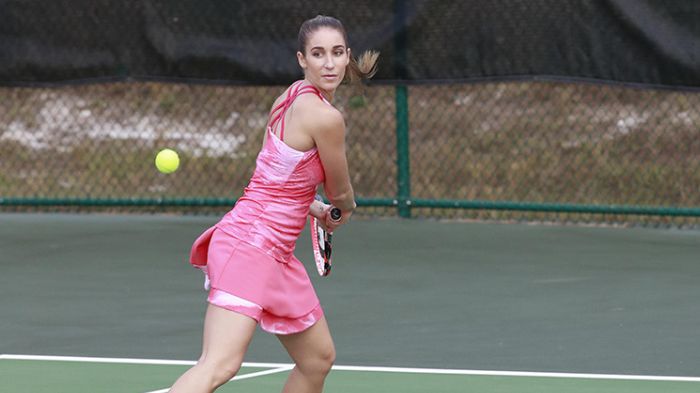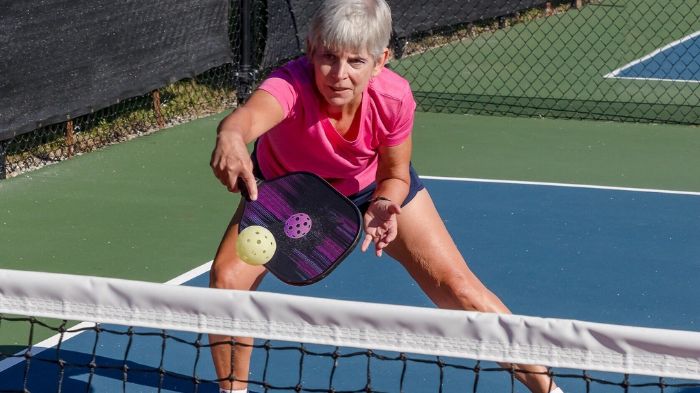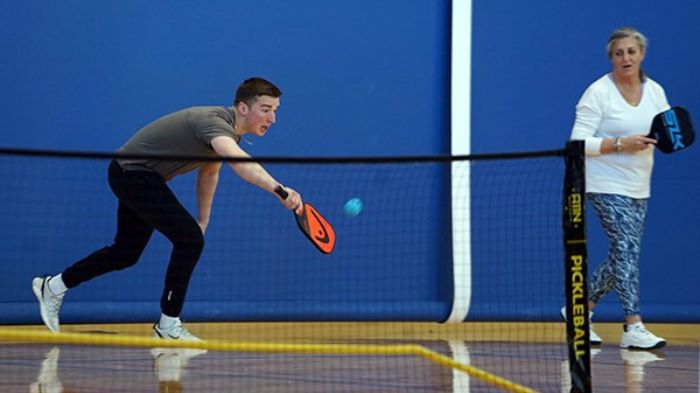Pickleball is a sport that has gained immense popularity in recent years due to its thrilling and competitive nature. Whether you’re a seasoned player or just starting out, mastering the backhand shot can take your game to the next level. But did you know that there are several methods of executing a backhand shot in pickleball?
In this blog post, we’ll explore the different types of backhands and how they can be used to improve your gameplay. So get ready to enhance your skills with our guide on the various methods of backhand in pickleball.
What Is a Backhand in Pickleball?

In pickleball, a backhand shot is executed with the non-dominant hand on the opposite side of your body. This shot requires you to hit the ball with your paddle facing toward the net while swinging across your body.
The backhand shot in pickleball is essential for players who want to have a well-rounded game. It allows players to return shots that are hit on their non-dominant side and can be used to surprise opponents who may be expecting shots from another angle.
To execute a strong backhand shot, it’s important to maintain proper form and footwork. Players should keep their feet shoulder-width apart and focus on rotating their hips and shoulders as they swing through the ball.
While mastering this shot may take some time and practice, adding it to your arsenal will undoubtedly improve your gameplay and make you a more versatile player on the court.
Methods of Backhand
Pickleball is a game that requires players to have a strong backhand shot as it is used frequently during gameplay. There are several types of backhand shots in pickleball, and each player can choose the technique that suits them best. Here are some common methods used for backhand shots in pickleball:
Traditional Backhand
The traditional backhand is the most common and straightforward method used for backhand shots in pickleball. This involves hitting the ball with your racquet on the same side as your non-dominant hand. This method requires you to rotate your body slightly and extend your arm across the front of your body. It is a simple technique that can be used by players of all skill levels.
Reverse Forehand-Backhand
The reverse forehand-backhand is a more advanced technique that allows for greater control over direction and spin. With this method, you start with a forehand motion before quickly transitioning into a backhand shot by flicking your wrist at impact. This technique requires more skill and practice than the traditional backhand shot.
Inside-Out or Cross-Court Slice
The inside-out or cross-court slice is a variation of the backhand shot. This technique involves slicing under and across the ball, causing it to curve away from your opponent towards either sideline. This shot is particularly useful when trying to hit a cross-court shot or when you want to get your opponent off-balance.
To become a skilled player in pickleball, it’s essential to practice all three techniques so that you can use them effectively during gameplay. However, it’s important to note that each player may have a preferred backhand shot based on their personal preference and skill level. Experimenting with different techniques and finding the one that suits you best can improve your gameplay and overall performance.
How to Hit a Backhand Serve in Pickleball?

Steps to Hitting a Backhand Serve in Pickleball
- Start with the correct grip: Use an eastern backhand grip by holding the paddle with your dominant hand as if you were shaking someone’s hand.
- Position yourself behind the baseline: Your feet should be shoulder-width apart and pointed towards the net.
- Begin the serve motion: Drop your non-dominant arm and bring your dominant arm back while keeping it parallel to the ground.
- Swing forward: As you swing forward for contact with the ball, shift your weight onto your front foot while following through with your arm across your body.
- Keep a loose wrist: This allows for better control of where you want the ball to go on the court.
- Aim high: When hitting a backhand serve in pickleball, aim high over the net and towards either sideline or middle of the service area of the opposing team’s side of the court based on strategy.
- Consistent practice: With consistent practice and attention to form details like these will improve both power & accuracy which leads ultimately lead to success on the court.
What Are the Benefits of Backhand Serving?
Pickleball players who have perfected their technique can get a variety of rewards from backhand serving. It enables players to vary their serves and misdirect opponents, which is one big benefit. Players can increase their chances of scoring by integrating both forehand and backhand serves into their performance.
The backhand serve’s capacity to disrupt an opponent’s rhythm is another advantage. Your opponent might get accustomed to the speed and spin of your shots if you frequently serve with your forehand. This trend can be broken by using a backhand serve differently, which can assist you on the court.
Backhand serving also gives players more control over where they place the ball on the court. With proper technique, players can vary the speed, angle, and placement of their serves, making it hard for opponents to anticipate where the ball will land. Mastering different types of backhands in pickleball adds versatility and unpredictability to a player’s game while also giving them more accuracy and command over their shots.
The Reverse Forehand Backhand
In pickleball, backhand shots are an essential part of a player’s arsenal. They can be used to return volleys, serve the ball, and even hit a winning shot. But how many types of backhand shots are there?
There are primarily two methods of hitting a backhand shot in pickleball. The traditional backhand and the reverse forehand backhand.

Which Method is Better?
The choice between the traditional backhand and the reverse forehand backhand comes down to personal preference and skill level. Some players find the traditional backhand more comfortable, while others prefer the reverse forehand for its added power and versatility.
Importance of a Backhand Serve
While it is not necessary to use a backhand serve in pickleball, having a reliable backhand serve can give you an advantage over opponents who struggle with returning those types of serves.
Learning to Hit a Proper Backhanded Shot
Can beginners learn how to hit a proper backhanded shot quickly? With practice and dedication, beginners can improve their technique for both traditional and reverse forehand backhands. However, mastering these shots may take time depending on your natural ability and experience playing sports similar to pickleball.
Common Mistakes to Avoid
As with any skill, there are common mistakes that beginner players make when attempting a backhanded shot. Some of these include improper grip, poor footwork leading up to hitting the ball, and swinging too early or late, resulting in missed shots or weak returns. Practice and attention to form detail like these can improve both power and accuracy, which ultimately leads to success on the court.
FAQs
It ultimately depends on personal preference and skill level. Some players find the traditional backhand more comfortable, while others prefer the reverse forehand for its added power and versatility.
With practice and dedication, beginners can improve their technique for both traditional and reverse forehand backhands. However, mastering these shots may take time depending on your natural ability and experience playing sports similar to pickleball.
Some common mistakes include using an improper grip, poor footwork leading up to hitting the ball, and swinging too early or too late, resulting in missed shots or weak returns. It’s important to practice proper technique and form to avoid these mistakes and improve your backhand shots.
A: Pickleball is played on a smaller court than tennis or badminton, and the ball used is lighter and travels at a slower speed, making it easier for beginners and older adults to play. Additionally, pickleball uses a unique set of rules and scoring system that differs from other racket sports.
Let’s wrap up
To summarize, the backhand shot in pickleball is a crucial aspect of gameplay that every player should master. There are several types of backhands you can use to improve your game, including the traditional backhand and the reverse forehand backhand.
By incorporating these techniques into your gameplay, you’ll be able to hit more consistent shots and have greater control over where the ball goes. Additionally, mastering the art of serving with a backhand can give you a competitive edge on the court.
Ultimately, improving your skills as a pickleball player takes time and practice. By focusing on developing different types of backhands and learning how to execute them effectively during games, you’ll be well on your way to becoming an accomplished player who excels in all aspects of this fun and exciting sport!



